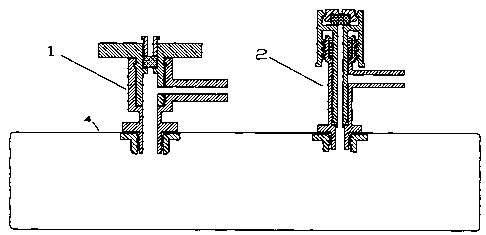Some of the information on this Web page has been provided by external sources. The Government of Canada is not responsible for the accuracy, reliability or currency of the information supplied by external sources. Users wishing to rely upon this information should consult directly with the source of the information. Content provided by external sources is not subject to official languages, privacy and accessibility requirements.
Any discrepancies in the text and image of the Claims and Abstract are due to differing posting times. Text of the Claims and Abstract are posted:
| (12) Patent Application: | (11) CA 2685449 |
|---|---|
| (54) English Title: | GAS SAMPLE BAG WITH TWO VALVES |
| (54) French Title: | SAC A ECHANTILLON DE GAZ AVEC DEUX VANNES MEDICALES |
| Status: | Deemed Abandoned and Beyond the Period of Reinstatement - Pending Response to Notice of Disregarded Communication |
| (51) International Patent Classification (IPC): |
|
|---|---|
| (72) Inventors : |
|
| (73) Owners : |
|
| (71) Applicants : |
|
| (74) Agent: | |
| (74) Associate agent: | |
| (45) Issued: | |
| (22) Filed Date: | 2009-08-13 |
| (41) Open to Public Inspection: | 2011-02-13 |
| Examination requested: | 2011-08-12 |
| Availability of licence: | N/A |
| Dedicated to the Public: | N/A |
| (25) Language of filing: | English |
| Patent Cooperation Treaty (PCT): | No |
|---|
| (30) Application Priority Data: | None |
|---|
A gas sample bag having two molded plastic valves is
described in the invention. Both stopcock valve and needle
valve have a septum that permits a portion of gas sample to be
withdrawn with a syringe. Both valves come with an arm for
filling gas sample. Both stopcock valve and needle valve have
excellent sealing property due to precision manufacturing
process, an O-ring and lubricant is not required. A flexible
synthetic fluoropolymer film with extreme low permeation
property and extreme chemical stability is used to form a
collapsible bag.
Note: Claims are shown in the official language in which they were submitted.
Note: Descriptions are shown in the official language in which they were submitted.

2024-08-01:As part of the Next Generation Patents (NGP) transition, the Canadian Patents Database (CPD) now contains a more detailed Event History, which replicates the Event Log of our new back-office solution.
Please note that "Inactive:" events refers to events no longer in use in our new back-office solution.
For a clearer understanding of the status of the application/patent presented on this page, the site Disclaimer , as well as the definitions for Patent , Event History , Maintenance Fee and Payment History should be consulted.
| Description | Date |
|---|---|
| Inactive: Adhoc Request Documented | 2013-05-15 |
| Application Not Reinstated by Deadline | 2013-04-11 |
| Inactive: Dead - No reply to s.30(2) Rules requisition | 2013-04-11 |
| Deemed Abandoned - Failure to Respond to Maintenance Fee Notice | 2012-08-13 |
| Inactive: Abandoned - No reply to s.29 Rules requisition | 2012-04-11 |
| Inactive: Abandoned - No reply to s.30(2) Rules requisition | 2012-04-11 |
| Inactive: S.30(2) Rules - Examiner requisition | 2011-10-11 |
| Inactive: S.29 Rules - Examiner requisition | 2011-10-11 |
| Letter Sent | 2011-08-19 |
| All Requirements for Examination Determined Compliant | 2011-08-12 |
| Request for Examination Requirements Determined Compliant | 2011-08-12 |
| Request for Examination Received | 2011-08-12 |
| Inactive: Office letter | 2011-03-21 |
| Change of Address Requirements Determined Compliant | 2011-03-21 |
| Change of Address or Method of Correspondence Request Received | 2011-03-14 |
| Inactive: Cover page published | 2011-02-13 |
| Application Published (Open to Public Inspection) | 2011-02-13 |
| Inactive: IPC assigned | 2010-03-25 |
| Inactive: IPC assigned | 2010-03-25 |
| Inactive: First IPC assigned | 2010-03-25 |
| Application Received - Regular National | 2009-12-10 |
| Filing Requirements Determined Compliant | 2009-12-10 |
| Inactive: Office letter | 2009-12-10 |
| Inactive: Filing certificate - No RFE (English) | 2009-12-10 |
| Small Entity Declaration Determined Compliant | 2009-08-13 |
| Abandonment Date | Reason | Reinstatement Date |
|---|---|---|
| 2012-08-13 |
The last payment was received on 2011-08-15
Note : If the full payment has not been received on or before the date indicated, a further fee may be required which may be one of the following
Please refer to the CIPO Patent Fees web page to see all current fee amounts.
| Fee Type | Anniversary Year | Due Date | Paid Date |
|---|---|---|---|
| Application fee - small | 2009-08-13 | ||
| Request for examination - small | 2011-08-12 | ||
| MF (application, 2nd anniv.) - small | 02 | 2011-08-15 | 2011-08-15 |
Note: Records showing the ownership history in alphabetical order.
| Current Owners on Record |
|---|
| CHANGRUN LU |
| Past Owners on Record |
|---|
| None |